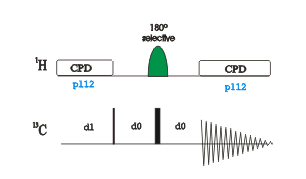|
|
The 2D Selective Heteronuclear J-Resolved experiment is the selective version of the spin-flip experiment. It allows to measure accurate long-range proton-carbon coupling constants directly from the F1 columns of a heteronuclear J-resolved spectrum.REQUIREMENTS
Easy implementation on any AVANCE spectrometer.VERSIONS

In this way, all 13C chemical shift and heteronuclear couplings except those of the inverted proton are refocus at the end of the evolution period.
Other alternatives are:
Some applications have been described: 85JCS220 , 94MRC657 , and 95MRC196 .
The 2D Heteronuclear J-Resolved experiment can be recorded in routine/automation modes. The parameters to be consider are the offset and the selectivity of the selective inversion proton pulse. The relaxation period must be enough long to relax all carbon nuclei.SPECTRATutorials: 2D X-detected experiments
The main advantage of selective 2D J experiments is the simple spectral analysis. It displays a typical proton-decoupled 13C spectrum in the F2 dimension. Each 13C resonance is splitted as a function of the number of selected protons. Thus, for instance, a quadruplet centered to F1=0 (+3J/2, +J/2, -J/2, -3J/2) is observed for each carbon resonance if a methyl group has been selectively inverted, a triplet (+J, 0, -J) if a methylene has been inverted, an a doublet (+J/2 and -J/2) if a single proton has been inverted. Non coupled and unresolved carbons appear as a singlets at F1=0. The observed splitting directly affords the long-range proton-carbon coupling constant value. Because the F1 dimension can be set to a minimum value, the resolution of this measurement can be about 0.2-0.3 Hz.RELATED TOPICS
Related experiments:2D X-detected experiments